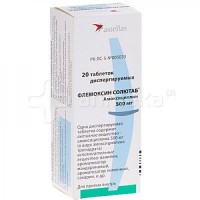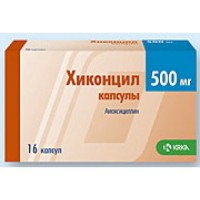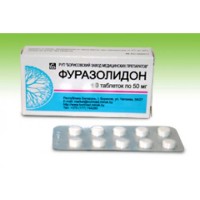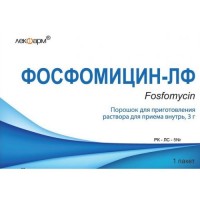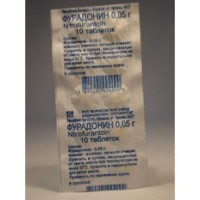The instruction for medical use
of EMIGIL™-F medicine
the Trade name
of Emigil™-F
the International unlicensed name
Is not present
the Dosage form
of the Tablet, film coated
Structure
One tablet contains
active agents: metronidazole of 400 mg,
furasolidone of 100 mg,
excipients: calcium hydrophosphate, starch corn, polyvinylpirrolidone (Kollidon-30), the talc purified magnesium stearate, starch sodium glycollate, silicon dioxide colloidal,
structure of a cover: a hydroksipropilmetiltsellyuloza, 2 propyl alcohol, methylene dichloride, ethyl cellulose, the talc purified, PEG-6000, propilenglyukol, the titan dioxide (E171), quinolinic yellow (E104), the water purified.
The description
of the Tablet, oval form with a biconvex surface, film coated light yellow color, with risky on one party.
Pharmacotherapeutic group
Antibacterial drugs for system use. Combination of germicides.
ATX J01RA code
Pharmacological
Pharmacokinetics Metronidazole Absorption properties: metronidazole is usually well soaked up after intake, peak plasma concentration are reached in 1-2 hours, the bioavailability is from 80 to 100%.
Distribution: metronidazole is quickly and widely distributed on all organism. Drug is found in cerebrospinal fluid, saliva, breast milk in the concentration equal to defined in plasma. In 4 – 6 hours the concentration of metronidazole in fabrics and liquor reaches 80 – 90% of concentration in blood serum. Bactericidal concentration of metronidazole were also found in purulent contents in liver abscesses.
Metabolism: less than 20% of the metronidazole circulating in blood contact proteins of plasma. Level of presistemny metabolism of active substance is extremely small. Metronidazole is metabolized in a liver due to oxidation. 2 metabolites are formed: the main alcoholic metabolite, about, 30% antibacterial activity of metronidazole concerning anaerobic bacteria, a acid metabolite have, come to light in small quantities, about, 5% have antibacterial activity of metronidazole. Metabolism of drug is slowed down at patients with liver diseases. At patients with a renal failure the accumulation of metabolites can be noted.
Removal: after intake the elimination half-life makes from 6 to 9 hours. In 48 hours about 60-80% of the general dose are removed: 10-20% in the form of initial substance, 30-40% - in the form of the main hydroxymetabolite, which elimination half-life about 11 h, and 10-20% - in the form of an acid metabolite. Generally metronidazole and its metabolites are removed with urine (60 - 80% of a dose), from 6 to 15% of a dose are removed with a stake. The renal failure does not influence pharmacokinetics of a single dose of metronidazole. However the plasma clearance of metronidazole decreases in an abnormal liver function.
Metronidazole and its metabolites quickly are removed at a hemodialysis (elimination half-life is reduced to 2.6 h). At peritoneal dialysis it is removed in insignificant quantities.
Furasolidone
Absorption: at intake it is well soaked up in digestive tract. The bioavailability is 30%. The maximum concentration of furasolidone in blood plasma after reception in a dose of 100 mg makes 0.25-0.43 mkg/ml and is reached in 1.85-3.0 h.
Distribution: time of maintaining therapeutic concentration in blood plasma – 4-6 hours. Furasolidone badly contacts proteins of plasma. Easily gets through a placenta, a blood-brain barrier. Very well gets into a lymph. High therapeutic concentrations of drug are noted in an intestines gleam.
Metabolism: after absorption, drug is quickly metabolized in an organism, mainly in a liver, with formation pharmacological of an inactive amin derivative of a metabolite.
Removal: elimination half-life from blood, on average, 30 min. It is removed mainly by kidneys, as in an invariable look - 65%, and in the form of pharmacological inactive metabolite. At the patients having a renal failure the accumulation of drug in an organism due to reduction in the rate of its removal is noted by kidneys.
A pharmacodynamics
of Emigil™-F – the combined antibacterial, anti-protozoan agent.
Metronidazole
the Mechanism of action consists in biochemical restoration 5 nitrogroups of metronidazole intracellular transport proteins of anaerobic microorganisms and protozoa with formation of the active intermediate agent causing oppression of synthesis of deoxyribonucleic acid (DNA) of a cell, loss of helical structure, a rupture of DNA threads and death of a bacterial cell.
Metronidazole has bactericidal activity concerning the majority of strains of anaerobic bacteria, is especially active concerning strains of Bacteroides fragilis and sibling species, Fusobacterium, Clostridium, Peptococcus and Peptostreptococcus spp.
Metronidazole is highly effective concerning protozoa, such as Trichomonas vaginalis, Giardia lamblia and Entamoeba histolytica.
Furasolidone
Furasolidone has bacteriostatic and bactericidal action due to disturbance of fermental systems of bacteria that minimizes development of steady microorganisms. The mechanism of action is connected with restoration of furasolidone in cells of microorganisms under the influence of flavoprotein (at aerobic organisms) and ferredoksinreduktaza (at anaerobic organisms and parasitic protozoa) in active the intermediant who damages ribosomalny proteins, breaks synthesis of protein, DNA, RNA.
Furasolidone possesses a wide range of antibacterial activity concerning the majority of the pathogenic microorganisms causing digestive tract infections including E. coli, Staphylococci, Salmonella, Shigella, Proteus, Aerobacter aerogenes, Vibrio cholerae and Enterobacter spp. It is active concerning the simplest Trichomonas vaginalis, Giardia lamblia. Poorly influences on causative agents of a purulent and mephitic gangrene Pseudomonas aeruginosa, Acinetobacter spp. Microbic drug resistance develops slowly.
Furasolidone does not cause significant changes in normal indestinal flora and also does not cause the overgrowth of fungi.
Indications
- the diarrheas caused by bacteria, protozoa or the mixed etiology
- dysentery
- food toxicoinfections
- an amebiasis
- a giardiasis
the Route of administration and doses
the Adult. Accept inside, without chewing, in time or after a meal.
In the diarrheas caused by bacteria, protozoa or the mixed etiology, dysentery, food toxicoinfections appoint on 1 tablet in 3 receptions in 8 hours within 5-7 days.
At most of patients the effect of treatment is observed in 1-2 days. However for achievement of adequate control of an infection the treatment is continued within 5 days. If the satisfactory clinical answer is not received within 7 days, it means that the activator refrakteren to effect of active agents and administration of drug should be stopped.
At an amebiasis appoint on 1 tablet 3 times a day within 7 days.
In a giardiasis accept on 1 tablet 3 times a day within 5 days.
The maximum single dose – 1 tablet for adults.
The maximum daily dose – 3 tablets for adults.
In renal failures (clearance of creatinine up to 10 ml/min.) the daily dose has to be reduced twice.
Side effects
Often (≥1/100, & lt, 1/10)
- nausea, vomiting
- dizziness, a headache
Sometimes (≥1/1000, & lt, 1/100)
- dryness in a mouth, emergence of a fur
- urine incontinence, coloring of urine in red-brown color because of existence of the water-soluble pigments formed as a result of metabolism of medicinal substance
- pains in epigastriums, gastric discomfort and spasms, a constipation or a diarrhea
- reversible deviations of functional trials of a liver
- cholestatic hepatitis, an abnormal liver function
- the pancreatitis reversible after the termination of treatment
is rare (≥1/10,000, & lt, 1/1000)
- urticaria, skin rash, congestion of a nose, a Quincke's edema
- metal smack in a mouth, a glossitis, stomatitis, anorexia, intestinal colic, a proctitis
- confusion of consciousness, irritability, a depression, hyperexcitability, spasms, hallucinations, sonitus, sleep disorders
- the peripheral neuropathy which is characterized generally by numbness or paresthesia of extremities, a lack of coordination of movements
- a dysuria, cystitis, a polyuria
- candidiasis
- feeling of weakness, fever, a dermahemia
- arthralgias
- a neutropenia, a leukopenia, thrombocytopenia, an agranulocytosis
- dryness mucous vaginas and vulvas
- decrease in a libido (sexual desire)
- cough, short wind
- decrease in visual acuity as a result of passing disturbances of a refraction
- the strengthened heartbeat, stethalgias, a lowering of arterial pressure, flattening of a tooth of T on the ECG
of the Contraindication
- hypersensitivity to nitroimidazoles and furasolidone or to any other ingredients of drug
- a blood disease, the leukopenia (including in the anamnesis)
- organic lesions of the central nervous system (including epilepsy)
- a liver failure (in case of purpose of high doses)
- the profound renal failures (clearance of creatinine less than 10 ml/min.), an oliguria
- the combined reception with Disulfiramum
- the combined reception with alcohol
- a sharp porphyria
- pregnancy and the period of a lactation
- children's and teenage age up to 18 years
Medicinal interaction
Metronidazole strengthens anticoagulating effect of warfarin and other oral coumarinic anticoagulants, causing lengthening of a prothrombin time therefore at co-administration, their doses need to be reduced.
Cimetidinum inhibits metronidazole metabolism that can lead to increase in its concentration in blood serum, extend elimination half-life of metronidazole and reduce plasma clearance of metronidazole and to increase in risk of development of by-effects.
At a concomitant use with drugs of lithium the concentration of the last in plasma and development of symptoms of lithium intoxication can increase.
It is not recommended to combine with not depolarizing muscle relaxants (a vekuroniya bromide).
Co-administration of the drugs stimulating enzymes of microsomal oxidation in a liver (phenobarbital, Phenytoinum) can accelerate metronidazole elimination therefore its concentration in plasma goes down. It was reported also about disturbance of clearance of Phenytoinum.
Эмигил™-Ф similar to Disulfiramum, causes intolerance of ethanol. For prevention of development of disulfiramopodobny reactions in patients, it is necessary to avoid intake of alcoholic beverages during drug treatment and after a while after treatment. Simultaneous use with Disulfiramum can lead to development of various neurologic symptoms, such as delirium attacks, the confused consciousness (an interval between appointment – not less than 2 weeks).
The furasolidone which is a part of Emigila™-F is monoaminooxidase inhibitor therefore it is necessary to observe extra care at joint purpose of Emigila™-F with sympathomimetics of indirect action (Phenylephrinum, ephedrine) and the means reducing appetite (amphetamine).
It was reported about development of toxic psychosis in the patient receiving furasolidone together with amitriptyline.
It is necessary to be careful and reduce doses of sedative, antihistaminic drugs, tranquilizers and drugs if their joint appointment with furasolidone is required.
Reception of tiraminsoderzhashchy products, such as bean products, extract of yeast, firm grades of not pasteurized cheese, beer, wine, marinated herring, liver of chicken and the products fermenting is contraindicated.
The special
instructions Alcohol intake during treatment of Emigilom™-F or during, at least, the day following drug withdrawal, can make abdominal pain, sick, vomiting, a headache and feeling of inflows to the person.
Treatment should be stopped in case of an ataxy, dizziness and confusion of consciousness. It is necessary to remember possible deterioration in the neurologic status at patients with heavy, chronic or active disturbances of the central and peripheral nervous system.
At patients with the profound abnormal liver functions it is necessary to consider a possibility of cumulation (accumulation) of metronidazole in blood plasma. It is necessary to be careful when assigning Emigila™-F to this group of patients, the dose decline is recommended.
In case of treatment of an amebiasis, especially if the repeated course of therapy by drug is necessary, define number of leukocytes in blood and their formula prior to the beginning of and after the end of treatment.
During the Emigil™-F drug treatment (at the expense of metronidazole) the wrong results of researches in blood of transaminases, a lactate dehydrogenase and triglycerides can be received. Metronidazole can immobilize treponemas, yielding false positive result in the immobilized Treponema pallidum test at diagnosis of syphilis.
At drug treatment the development or exacerbation of the available latent candidiasis is possible that demands purpose of antifungal therapy.
At long therapy of Emigilom™-F because of the furasolidone which is a part the orthostatic hypotension and a hypoglycemia can develop.
Furasolidone can cause easy reversible intravascular hemolysis because of presence of inborn defect of metabolism of erythrocytes in small percent of some ethnic groups which are especially predisposed to hemolysis as a result of influence of many drugs. Strict observation of such patients is necessary during treatment of Emigilom™-F, at emergence of signs of hemolysis it is necessary to stop administration of drug.
It is necessary to adjust a dose of oral anticoagulants during treatment
of Emigilom™-F and within one week after the treatment termination. It is necessary to control to a thicket the level of a prothrombin and to carry out monitoring of the prothrombin time (PT) taking into account the international normalized relation (INR) which is defined as the relation of PV of the patient to control PV.
The brown coloring of urine appearing at reception of therapeutic doses has no clinical value.
The feature of influence of drug on ability to run transport and potentially dangerous mechanisms
Due to a possibility of development of dizziness against the background of administration of drug should be careful to patients whose activity requires special attention and speed of psychomotor reactions.
Overdose
Symptoms: nausea, vomiting, spasms, peripheral neuropathy, ataxy. It was reported about development of neurotoxic effects, such as spasms and peripheral neuropathy, after reception of high doses from 6 g to 10.4 g every other day within 5-7 days.
Treatment: there is no specific antidote, at overdose the gastric lavage, a hemodialysis, symptomatic and maintenance therapy is carried out.
The form of release and packing
On 10 tablets pack into blister strip packaging from polyvinylchloride and aluminum foil.
On 1 planimetric packing together with the instruction for medical use in the state and Russian languages place in a cardboard pack.
To Store storage conditions in the dry, protected from light place at a temperature not over 250C.
To store out of children's reach!
Not to apply a period of storage of 5 years after expiry date.
Prescription status
According to the prescription
Plethico Pharmaceuticals LTD Producer
of Dharavar, Kalariya – 453,001, Indore, India.
The owner of the registration certificate
of Plethico Pharmaceuticals LTD, India
the Address of the organization accepting in the territory of the Republic of Kazakhstan claims from consumers on quality of products (goods) of Rezlov Ltd LLP, 100009, Karaganda Ermekov St. 110/2tel.+7 (212) 48-16-44, fax +7 (212) 48-17-44Адрес e-mail: rezlov_ltd@mail.ru, rezlov-ltd@rambler.ru
to Develop
of EMIGIL™-F medicine
the Trade name
of Emigil™-F
the International unlicensed name
Is not present
the Dosage form
of the Tablet, film coated
Structure
One tablet contains
active agents: metronidazole of 400 mg,
furasolidone of 100 mg,
excipients: calcium hydrophosphate, starch corn, polyvinylpirrolidone (Kollidon-30), the talc purified magnesium stearate, starch sodium glycollate, silicon dioxide colloidal,
structure of a cover: a hydroksipropilmetiltsellyuloza, 2 propyl alcohol, methylene dichloride, ethyl cellulose, the talc purified, PEG-6000, propilenglyukol, the titan dioxide (E171), quinolinic yellow (E104), the water purified.
The description
of the Tablet, oval form with a biconvex surface, film coated light yellow color, with risky on one party.
Pharmacotherapeutic group
Antibacterial drugs for system use. Combination of germicides.
ATX J01RA code
Pharmacological
Pharmacokinetics Metronidazole Absorption properties: metronidazole is usually well soaked up after intake, peak plasma concentration are reached in 1-2 hours, the bioavailability is from 80 to 100%.
Distribution: metronidazole is quickly and widely distributed on all organism. Drug is found in cerebrospinal fluid, saliva, breast milk in the concentration equal to defined in plasma. In 4 – 6 hours the concentration of metronidazole in fabrics and liquor reaches 80 – 90% of concentration in blood serum. Bactericidal concentration of metronidazole were also found in purulent contents in liver abscesses.
Metabolism: less than 20% of the metronidazole circulating in blood contact proteins of plasma. Level of presistemny metabolism of active substance is extremely small. Metronidazole is metabolized in a liver due to oxidation. 2 metabolites are formed: the main alcoholic metabolite, about, 30% antibacterial activity of metronidazole concerning anaerobic bacteria, a acid metabolite have, come to light in small quantities, about, 5% have antibacterial activity of metronidazole. Metabolism of drug is slowed down at patients with liver diseases. At patients with a renal failure the accumulation of metabolites can be noted.
Removal: after intake the elimination half-life makes from 6 to 9 hours. In 48 hours about 60-80% of the general dose are removed: 10-20% in the form of initial substance, 30-40% - in the form of the main hydroxymetabolite, which elimination half-life about 11 h, and 10-20% - in the form of an acid metabolite. Generally metronidazole and its metabolites are removed with urine (60 - 80% of a dose), from 6 to 15% of a dose are removed with a stake. The renal failure does not influence pharmacokinetics of a single dose of metronidazole. However the plasma clearance of metronidazole decreases in an abnormal liver function.
Metronidazole and its metabolites quickly are removed at a hemodialysis (elimination half-life is reduced to 2.6 h). At peritoneal dialysis it is removed in insignificant quantities.
Furasolidone
Absorption: at intake it is well soaked up in digestive tract. The bioavailability is 30%. The maximum concentration of furasolidone in blood plasma after reception in a dose of 100 mg makes 0.25-0.43 mkg/ml and is reached in 1.85-3.0 h.
Distribution: time of maintaining therapeutic concentration in blood plasma – 4-6 hours. Furasolidone badly contacts proteins of plasma. Easily gets through a placenta, a blood-brain barrier. Very well gets into a lymph. High therapeutic concentrations of drug are noted in an intestines gleam.
Metabolism: after absorption, drug is quickly metabolized in an organism, mainly in a liver, with formation pharmacological of an inactive amin derivative of a metabolite.
Removal: elimination half-life from blood, on average, 30 min. It is removed mainly by kidneys, as in an invariable look - 65%, and in the form of pharmacological inactive metabolite. At the patients having a renal failure the accumulation of drug in an organism due to reduction in the rate of its removal is noted by kidneys.
A pharmacodynamics
of Emigil™-F – the combined antibacterial, anti-protozoan agent.
Metronidazole
the Mechanism of action consists in biochemical restoration 5 nitrogroups of metronidazole intracellular transport proteins of anaerobic microorganisms and protozoa with formation of the active intermediate agent causing oppression of synthesis of deoxyribonucleic acid (DNA) of a cell, loss of helical structure, a rupture of DNA threads and death of a bacterial cell.
Metronidazole has bactericidal activity concerning the majority of strains of anaerobic bacteria, is especially active concerning strains of Bacteroides fragilis and sibling species, Fusobacterium, Clostridium, Peptococcus and Peptostreptococcus spp.
Metronidazole is highly effective concerning protozoa, such as Trichomonas vaginalis, Giardia lamblia and Entamoeba histolytica.
Furasolidone
Furasolidone has bacteriostatic and bactericidal action due to disturbance of fermental systems of bacteria that minimizes development of steady microorganisms. The mechanism of action is connected with restoration of furasolidone in cells of microorganisms under the influence of flavoprotein (at aerobic organisms) and ferredoksinreduktaza (at anaerobic organisms and parasitic protozoa) in active the intermediant who damages ribosomalny proteins, breaks synthesis of protein, DNA, RNA.
Furasolidone possesses a wide range of antibacterial activity concerning the majority of the pathogenic microorganisms causing digestive tract infections including E. coli, Staphylococci, Salmonella, Shigella, Proteus, Aerobacter aerogenes, Vibrio cholerae and Enterobacter spp. It is active concerning the simplest Trichomonas vaginalis, Giardia lamblia. Poorly influences on causative agents of a purulent and mephitic gangrene Pseudomonas aeruginosa, Acinetobacter spp. Microbic drug resistance develops slowly.
Furasolidone does not cause significant changes in normal indestinal flora and also does not cause the overgrowth of fungi.
Indications
- the diarrheas caused by bacteria, protozoa or the mixed etiology
- dysentery
- food toxicoinfections
- an amebiasis
- a giardiasis
the Route of administration and doses
the Adult. Accept inside, without chewing, in time or after a meal.
In the diarrheas caused by bacteria, protozoa or the mixed etiology, dysentery, food toxicoinfections appoint on 1 tablet in 3 receptions in 8 hours within 5-7 days.
At most of patients the effect of treatment is observed in 1-2 days. However for achievement of adequate control of an infection the treatment is continued within 5 days. If the satisfactory clinical answer is not received within 7 days, it means that the activator refrakteren to effect of active agents and administration of drug should be stopped.
At an amebiasis appoint on 1 tablet 3 times a day within 7 days.
In a giardiasis accept on 1 tablet 3 times a day within 5 days.
The maximum single dose – 1 tablet for adults.
The maximum daily dose – 3 tablets for adults.
In renal failures (clearance of creatinine up to 10 ml/min.) the daily dose has to be reduced twice.
Side effects
Often (≥1/100, & lt, 1/10)
- nausea, vomiting
- dizziness, a headache
Sometimes (≥1/1000, & lt, 1/100)
- dryness in a mouth, emergence of a fur
- urine incontinence, coloring of urine in red-brown color because of existence of the water-soluble pigments formed as a result of metabolism of medicinal substance
- pains in epigastriums, gastric discomfort and spasms, a constipation or a diarrhea
- reversible deviations of functional trials of a liver
- cholestatic hepatitis, an abnormal liver function
- the pancreatitis reversible after the termination of treatment
is rare (≥1/10,000, & lt, 1/1000)
- urticaria, skin rash, congestion of a nose, a Quincke's edema
- metal smack in a mouth, a glossitis, stomatitis, anorexia, intestinal colic, a proctitis
- confusion of consciousness, irritability, a depression, hyperexcitability, spasms, hallucinations, sonitus, sleep disorders
- the peripheral neuropathy which is characterized generally by numbness or paresthesia of extremities, a lack of coordination of movements
- a dysuria, cystitis, a polyuria
- candidiasis
- feeling of weakness, fever, a dermahemia
- arthralgias
- a neutropenia, a leukopenia, thrombocytopenia, an agranulocytosis
- dryness mucous vaginas and vulvas
- decrease in a libido (sexual desire)
- cough, short wind
- decrease in visual acuity as a result of passing disturbances of a refraction
- the strengthened heartbeat, stethalgias, a lowering of arterial pressure, flattening of a tooth of T on the ECG
of the Contraindication
- hypersensitivity to nitroimidazoles and furasolidone or to any other ingredients of drug
- a blood disease, the leukopenia (including in the anamnesis)
- organic lesions of the central nervous system (including epilepsy)
- a liver failure (in case of purpose of high doses)
- the profound renal failures (clearance of creatinine less than 10 ml/min.), an oliguria
- the combined reception with Disulfiramum
- the combined reception with alcohol
- a sharp porphyria
- pregnancy and the period of a lactation
- children's and teenage age up to 18 years
Medicinal interaction
Metronidazole strengthens anticoagulating effect of warfarin and other oral coumarinic anticoagulants, causing lengthening of a prothrombin time therefore at co-administration, their doses need to be reduced.
Cimetidinum inhibits metronidazole metabolism that can lead to increase in its concentration in blood serum, extend elimination half-life of metronidazole and reduce plasma clearance of metronidazole and to increase in risk of development of by-effects.
At a concomitant use with drugs of lithium the concentration of the last in plasma and development of symptoms of lithium intoxication can increase.
It is not recommended to combine with not depolarizing muscle relaxants (a vekuroniya bromide).
Co-administration of the drugs stimulating enzymes of microsomal oxidation in a liver (phenobarbital, Phenytoinum) can accelerate metronidazole elimination therefore its concentration in plasma goes down. It was reported also about disturbance of clearance of Phenytoinum.
Эмигил™-Ф similar to Disulfiramum, causes intolerance of ethanol. For prevention of development of disulfiramopodobny reactions in patients, it is necessary to avoid intake of alcoholic beverages during drug treatment and after a while after treatment. Simultaneous use with Disulfiramum can lead to development of various neurologic symptoms, such as delirium attacks, the confused consciousness (an interval between appointment – not less than 2 weeks).
The furasolidone which is a part of Emigila™-F is monoaminooxidase inhibitor therefore it is necessary to observe extra care at joint purpose of Emigila™-F with sympathomimetics of indirect action (Phenylephrinum, ephedrine) and the means reducing appetite (amphetamine).
It was reported about development of toxic psychosis in the patient receiving furasolidone together with amitriptyline.
It is necessary to be careful and reduce doses of sedative, antihistaminic drugs, tranquilizers and drugs if their joint appointment with furasolidone is required.
Reception of tiraminsoderzhashchy products, such as bean products, extract of yeast, firm grades of not pasteurized cheese, beer, wine, marinated herring, liver of chicken and the products fermenting is contraindicated.
The special
instructions Alcohol intake during treatment of Emigilom™-F or during, at least, the day following drug withdrawal, can make abdominal pain, sick, vomiting, a headache and feeling of inflows to the person.
Treatment should be stopped in case of an ataxy, dizziness and confusion of consciousness. It is necessary to remember possible deterioration in the neurologic status at patients with heavy, chronic or active disturbances of the central and peripheral nervous system.
At patients with the profound abnormal liver functions it is necessary to consider a possibility of cumulation (accumulation) of metronidazole in blood plasma. It is necessary to be careful when assigning Emigila™-F to this group of patients, the dose decline is recommended.
In case of treatment of an amebiasis, especially if the repeated course of therapy by drug is necessary, define number of leukocytes in blood and their formula prior to the beginning of and after the end of treatment.
During the Emigil™-F drug treatment (at the expense of metronidazole) the wrong results of researches in blood of transaminases, a lactate dehydrogenase and triglycerides can be received. Metronidazole can immobilize treponemas, yielding false positive result in the immobilized Treponema pallidum test at diagnosis of syphilis.
At drug treatment the development or exacerbation of the available latent candidiasis is possible that demands purpose of antifungal therapy.
At long therapy of Emigilom™-F because of the furasolidone which is a part the orthostatic hypotension and a hypoglycemia can develop.
Furasolidone can cause easy reversible intravascular hemolysis because of presence of inborn defect of metabolism of erythrocytes in small percent of some ethnic groups which are especially predisposed to hemolysis as a result of influence of many drugs. Strict observation of such patients is necessary during treatment of Emigilom™-F, at emergence of signs of hemolysis it is necessary to stop administration of drug.
It is necessary to adjust a dose of oral anticoagulants during treatment
of Emigilom™-F and within one week after the treatment termination. It is necessary to control to a thicket the level of a prothrombin and to carry out monitoring of the prothrombin time (PT) taking into account the international normalized relation (INR) which is defined as the relation of PV of the patient to control PV.
The brown coloring of urine appearing at reception of therapeutic doses has no clinical value.
The feature of influence of drug on ability to run transport and potentially dangerous mechanisms
Due to a possibility of development of dizziness against the background of administration of drug should be careful to patients whose activity requires special attention and speed of psychomotor reactions.
Overdose
Symptoms: nausea, vomiting, spasms, peripheral neuropathy, ataxy. It was reported about development of neurotoxic effects, such as spasms and peripheral neuropathy, after reception of high doses from 6 g to 10.4 g every other day within 5-7 days.
Treatment: there is no specific antidote, at overdose the gastric lavage, a hemodialysis, symptomatic and maintenance therapy is carried out.
The form of release and packing
On 10 tablets pack into blister strip packaging from polyvinylchloride and aluminum foil.
On 1 planimetric packing together with the instruction for medical use in the state and Russian languages place in a cardboard pack.
To Store storage conditions in the dry, protected from light place at a temperature not over 250C.
To store out of children's reach!
Not to apply a period of storage of 5 years after expiry date.
Prescription status
According to the prescription
Plethico Pharmaceuticals LTD Producer
of Dharavar, Kalariya – 453,001, Indore, India.
The owner of the registration certificate
of Plethico Pharmaceuticals LTD, India
the Address of the organization accepting in the territory of the Republic of Kazakhstan claims from consumers on quality of products (goods) of Rezlov Ltd LLP, 100009, Karaganda Ermekov St. 110/2tel.+7 (212) 48-16-44, fax +7 (212) 48-17-44Адрес e-mail: rezlov_ltd@mail.ru, rezlov-ltd@rambler.ru
to Develop


